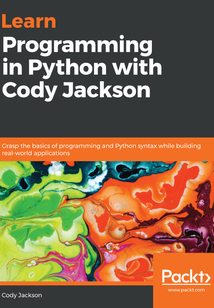首頁 > 計(jì)算機(jī)網(wǎng)絡(luò) >
編程語言與程序設(shè)計(jì)
> Learn Programming in Python with Cody Jackson最新章節(jié)目錄
舉報(bào) 

會(huì)員
Learn Programming in Python with Cody Jackson
Pythonisacross-platformlanguageusedbyorganizationssuchasGoogleandNASA.Itletsyouworkquicklyandefficiently,allowingyoutoconcentrateonyourworkratherthanthelanguage.Basedonhispersonalexperienceswhenlearningtoprogram,LearnProgramminginPythonwithCodyJacksonprovidesahands-onintroductiontocomputerprogrammingutilizingoneofthemostreadableprogramminglanguages–Python.ItaimstoeducatereadersregardingsoftwaredevelopmentaswellashelpexperienceddevelopersbecomefamiliarwiththePythonlanguage,utilizingreal-worldlessonstohelpreadersunderstandprogrammingconceptsquicklyandeasily.Thebookstartswiththebasicsofprogramming,anddescribesPythonsyntaxwhiledevelopingtheskillstomakecompleteprograms.Inthefirstpartofthebook,readerswillbegoingthroughalltheconceptswithshortandeasy-to-understandcodesamplesthatwillpreparethemforthecomprehensiveapplicationbuiltinparts2and3.Thesecondpartofthebookwillexploretopicssuchasapplicationrequirements,buildingtheapplication,testing,anddocumentation.Itisherethatyouwillgetasolidunderstandingofbuildinganend-to-endapplicationinPython.Thenextpartwillshowyouhowtocompleteyourapplicationsbyconvertingtext-basedsimulationintoaninteractive,graphicaluserinterface,usingadesktopGUIframework.Afterreadingthebook,youwillbeconfidentindevelopingacompleteapplicationinPython,fromprogramdesigntodocumentationtodeployment.
目錄(176章)
倒序
- coverpage
- Title Page
- About Packt
- Why subscribe?
- Packt.com
- Contributors
- About the author
- About the reviewers
- Packt is searching for authors like you
- Preface
- Who this book is for
- What this book covers
- To get the most out of this book
- Download the example code files
- Download the color images
- Conventions used
- Get in touch
- Reviews
- The Fundamentals of Python
- What is Python?
- Python versions
- Interpreted versus compiled
- Dynamic versus static
- Python 2 versus Python 3 division
- Working with Python
- Installation
- Launching the Python interpreter
- Windows (Win8 and above)
- Mac
- Using the Python command prompt
- Commenting Python code
- Launching Python programs
- Using the IPython shell
- Summary
- Data Types and Modules
- Structuring code
- Multiple line spanning
- Common data types
- Python numbers
- Strings
- Basic string operations
- Indexing and slicing strings
- String formatting
- Combining and separating strings
- Lists
- List usage
- Adding list elements
- Mutability
- Dictionaries
- Creating dictionaries
- Working with dictionaries
- Dictionary details
- Tuples
- Why use tuples?
- Sequence unpacking
- Sets
- Using data type methods
- Sequence methods
- String methods
- List methods
- Tuple methods
- Dictionary methods
- Set methods
- Importing modules
- Namespaces
- Dot nomenclature
- Types of imports
- Modules as scripts
- Summary
- Logic Control
- if...else statements
- Loops
- while loops
- for loops
- zip() function
- Exceptions
- Exception class hierarchy
- User-defined exceptions
- Final thoughts
- Summary
- Functions and Object Oriented Programming
- Working with functions
- Lambdas
- Classes methods and namespaces
- How are classes better?
- Classes and instances
- Modules
- Inheritance
- Operator overloading
- Properties and class and static methods
- Properties
- Getters and setters
- Class and static methods
- Summary
- Files and Databases
- File I/O
- Files and streams
- Reading from a file
- Iterating through files
- Seeking
- Serialization
- Python and SQLite
- Working with databases
- Using SQL to query a database
- Creating a SQLite database
- Retrieving data from a database
- SQLite database files
- SQLAlchemy
- Writing a SQLAlchemy database
- Filling and querying the database
- Summary
- Application Planning
- Software development life cycle
- Development practices and methodologies
- Incremental development
- Continuous integration
- Prototyping
- Rapid application development
- Waterfall development
- Spiral development
- Agile development
- Project requirements
- Software repositories
- Summary
- Writing the Imported Program
- Project requirements
- Utility functions
- Simulating storage tanks
- Name mangling
- Simulating valves
- Base valve class
- Gate valve class
- Globe valve class
- Relief valve class
- Simulation pumps
- Base pump class
- Centrifugal pump class
- Positive displacement pump class
- Summary
- Automated Software Testing
- Testing techniques
- Static versus dynamic tests
- White-box testing
- Black-box testing
- When to test
- Writing tests
- Refactoring code
- Summary
- Writing the Fueling Scenario
- Fueling scenario requirements
- Directory structure
- Component coding
- Functionality coding
- Testing
- Summary
- Software Post-Production
- Docstrings
- Sphinx documentation
- Lessons learned
- Summary
- Graphical User Interface Planning
- GUI functionality
- GUI elements
- Best practices
- User environment
- Graphical frameworks
- Summary
- Creating a Graphical User Interface
- Wireframing
- Coding the interface
- Kivy logic file
- Kivy layout file
- GUI testing
- Summary
- Other Books You May Enjoy
- Leave a review - let other readers know what you think 更新時(shí)間:2021-06-10 19:06:38
推薦閱讀
- Android Jetpack開發(fā):原理解析與應(yīng)用實(shí)戰(zhàn)
- 劍指JVM:虛擬機(jī)實(shí)踐與性能調(diào)優(yōu)
- C和C++安全編碼(原書第2版)
- Selenium Design Patterns and Best Practices
- Julia機(jī)器學(xué)習(xí)核心編程:人人可用的高性能科學(xué)計(jì)算
- Elastic Stack應(yīng)用寶典
- 假如C語言是我發(fā)明的:講給孩子聽的大師編程課
- Hands-On Swift 5 Microservices Development
- 精通Python設(shè)計(jì)模式(第2版)
- Cocos2d-x學(xué)習(xí)筆記:完全掌握Lua API與游戲項(xiàng)目開發(fā) (未來書庫)
- Lighttpd源碼分析
- JavaScript動(dòng)態(tài)網(wǎng)頁編程
- Image Processing with ImageJ
- 實(shí)戰(zhàn)Java高并發(fā)程序設(shè)計(jì)(第2版)
- ASP.NET 4.0 Web程序設(shè)計(jì)
- AutoCAD基礎(chǔ)教程
- C# 7.0本質(zhì)論
- XML程序設(shè)計(jì)(第二版)
- PHP 7 Programming Blueprints
- Mastering R for Quantitative Finance
- Learning Java by Building Android Games
- 梔子貓的奇幻編程之旅:21天探索信息學(xué)奧賽C++編程
- Ionic Cookbook
- Hybrid Mobile Development with Ionic
- Unity 游戲案例開發(fā)大全
- Learning Unity iOS Game Development
- 趣味學(xué)編程:特級(jí)教師帶你零基礎(chǔ)玩轉(zhuǎn)Mind+
- C語言學(xué)習(xí)指南:從規(guī)范編程到專業(yè)級(jí)開發(fā)
- C語言編程從零開始學(xué)(視頻教學(xué)版)
- Learning Heroku Postgres

